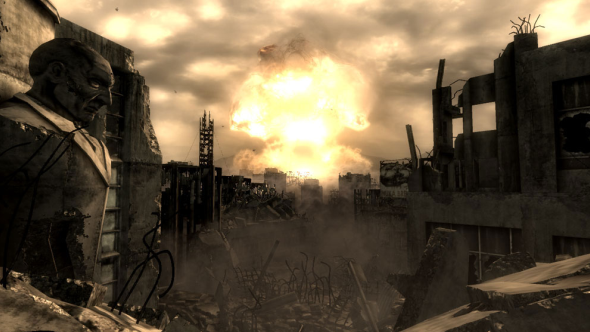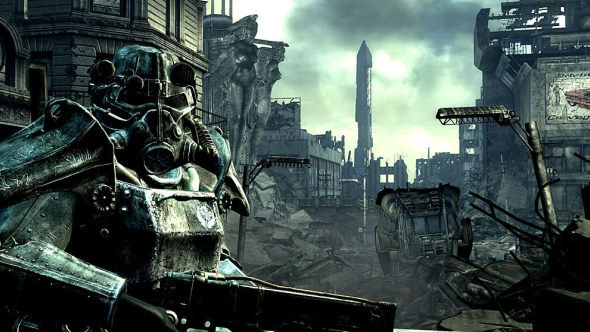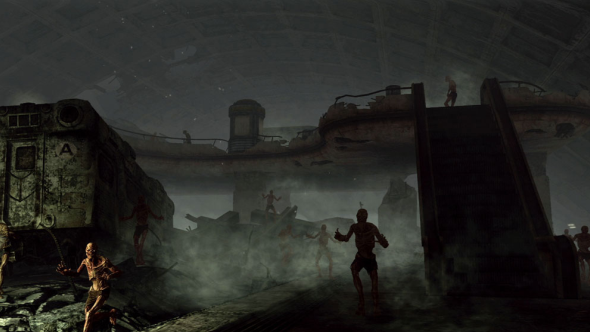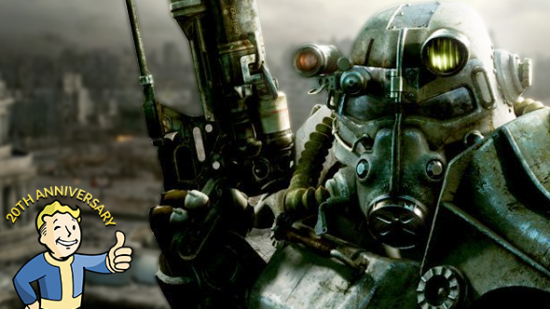This article is part of our week-long celebration of Fallout’s 20th anniversary. Make sure you check back throughout the week for more features.
Sometimes, when you load into a dungeon in Skyrim, you can see the exit. There is no glowing green sign; you are not supposed to notice it. But occasionally you will see a high passageway that opens into a cavern entrance, at such a height that entry is impossible from below. Lo and behold, once you have navigated those underground passageways – perhaps fought a lich and recovered an ancient weapon – you will find yourself tumbling a short distance from that passageway to the point at which you started. In a satisfying moment of recognition, the loop closes.
Related: what other Fallout locations would you like to see?
This is expert level design in action: a way of funneling you through an adventure before you have even noticed it happening. But it is also traditionalist in the extreme. This loop is part of a larger one, in which you delve into a dungeon, do a spot of looting, and return to the hamlet from whence you came. There you will sell your trinkets, treat your wounds, and set out to find the next dungeon with an even shinier sword.
It is perhaps the oldest paradigm in PC gaming. In fact, it predates PC gaming, beginning on the tabletop and becoming codified in computer RPGs during the ‘80s and ‘90s. Bethesda, who are hardly newcomers to the genre, played their part in defining it with The Elder Scrolls: Arena and Daggerfall. But with Fallout 3 they specifically set out to blur the lines.
“We knew early on that one of our big concepts for the game was to challenge the traditional RPG divisions between towns, wilderness, and dungeon,” Bethesda level designer Joel Burgess explains in a post-release blog.

Blessed with a dedicated level design team from day one – for the first time in the studio’s history – Bethesda were in the mood to experiment. And nowhere is that experimentation more apparent than in Fallout 3’s rendering of Washington, D.C. Or perhaps that should be ‘rending’. The idea is that the city – America’s capital, after all – had been the target of a direct atomic pounding. By the time we get there, D.C. is a tortured grey mass of steel beams and debris, like the inside of a crushed-car cube. Travelling overland is consequently near-impossible, and fraught with Super Mutant encounters, driving players into the metro tunnels: Bethesda’s biggest, most ambitious dungeon.
This dungeon broke all the rules. Mainly through size: these tunnels are not a self-contained loop you can easily get your head around, but a sprawling network of ancient stations, collapsed basements, and natural caves. They are overwhelming, by design.
“Players are not expected to ‘complete’ D.C. in the sense that one completes a traditional game level,” Burgess says.

The whole area is secreted with little cues intended to point out that fact, gently breaking down those expectations learned from decades of dungeon-delving. NPCs you meet in D.C. will tell you in no uncertain terms that the place is huge. Major areas are given unique names to suggest they are full-length experiences in and of themselves. And, perhaps most significantly, Bethesda broke up their dungeon into discrete map markers. These tiny squares encourage players to mentally compartmentalise the capital’s challenges and – as any Bethesda game player knows – double as fast travel points.
Soon enough, that familiar dungeon loop emerges in a newly organic fashion. There is a natural end point to a D.C. adventure you will probably recognise, and that is right around the moment you find yourself battling weight restrictions to keep your best loot. From there you can travel back to town, sell your trinkets, treat your wounds, and then return to the most recent checkpoint you uncovered in the capital’s ruins. There is always something else worth seeing: Bethesda gave themselves a mandate to make every train tunnel unique in some way.

“This is in response to one of our own criticisms of Oblivion, echoed by many fans of that game, which was the amount of repetition in dungeons,” Burgess explains. “Though we must re-use art assets out of necessity when creating such a large game, we made time for every space to be built and iterated upon by hand, by both level designers and artists.”
Part of Fallout 3’s legacy lies in setting the concept of a videogame dungeon free. Bethesda’s D.C. allows you to approach its dangers from different directions, in different orders, and still find a satisfying loop you can recognise as dungeon-spelunking. It is a far more open experience than the linear descent of the traditional dungeon, and you can still see variations on it today in Fallout 4’s Boston. There, Bethesda lift the dungeon high into the air, to become a network of meandering pathways between the creaking, yawning husks of skyscrapers. The liches might be called ghouls now, but make no mistake: the studio that helped define the RPG dungeon has taken great pleasure in pulling it apart.
Check out the rest of our Fallout 20th anniversary coverage:
- How did Fallout 1 ever get made?
- How Fallout 2 defined the series
- The time is right for a Fallout Tactics sequel
- Fallout 3’s Vault 101 is perfect
- Making New Vegas was a battle against time
- New Vegas is a perfect fit for Fallout’s dystopia
- New Vegas is the most adventurous Fallout game
- Come Fly With Me is the best New Vegas side-quest
- I became a prisoner of my own Fallout 4 settlement
- Fallout 4’s power armour symbolises how far the series’ combat has come
